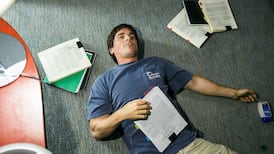Michael Dwyer reviews an unflinching depiction of man's inhumanity to man.
Hours after seeing The Passion of the Christ for the first time yesterday morning, the film continued to play on my mind. Mel Gibson, the film's director, producer and co-writer, has crafted a wrenchingly visceral drama based on the last 12 hours in the life of Jesus Christ. Just as its central character is shown no mercy whatsoever in the vicious torment to which he is subjected, so, too, is the movie utterly unsparing of its audience.
This is a film of such relentless, graphic violence that one does not merely watch it. Its focus is so intense that it transcends the movie-going experience by drawing in the viewer for a draining, gruelling immersion in its unflinching depiction of man's inhumanity to man.
Gibson's film is designed to produce feelings of shock and awe. The awe factor was an essential component of the Biblical movies produced with so much phoney reverence by Hollywood in the 1950s and early 1960s - The Robe, The Ten Commandments, The Greatest Story Ever Told, King of Kings, Barabbas.
These were mostly cynical, sanitised exercises, more likely to provoke yawns than shock, that tortured audiences only through their absurdly excessive running times, as if their self-important durations somehow equated with worthiness.
In The Passion of the Christ, Gibson rubs the viewer's nose in horrific torture, relentless cruelty and pools of blood. I cannot recall a more numbing experience in a cinema since the unbearable inhumanity and despairing nihilism of the 1975 Italian psychodrama, Salo. Ironically, that was the last film directed by Pier Paolo Pasolini, the Marxist responsible for the profoundly spiritual 1964 film, The Gospel According to St Matthew, which adopted a classically simple and powerfully effective neo-realist approach.
Based on the four Gospels and structured in the form of the Stations of the Cross, Gibson's film dares to use only Aramaic and Latin dialogue, translated in English sub-titles. Shot in muted, painterly tones, it begins with a moonlit scene of a lone and anguished Jesus in the garden of Gethsemane after the Last Supper. As he contemplates his fate, his hands trembling, he is being betrayed by one of his apostles, Judas, whose 30 pieces of silver are thrown at him in slow-motion.
Slithering in the darkness is an oddly androgynous Satan - played by a woman, we learn from the credits - and this personification of evil seems so misconceived that it initially threatens to topple the movie off its axis. Instead, it reclaims its dramatic impetus with the arrest of Jesus on blasphemy charges, as a baying mob demands his crucifixion.
In a movie that defines most of its characters by merely a distinguishing trait or two, making little demand on its actors, the most complex character to emerge is Pontius Pilate, the morally conflicted Roman governor subtly played by Bulgarian Hristo Naumov Shopov.
Jesus is drawn as an essentially passive character, a stoic victim subjected to incessant cruelty, and Hollywood actor Jim Caviezel heroically suffers in the role. Only in the succinct flashback sequences is he allowed to reveal the personality and charisma of Jesus - in a playful interlude between the young carpenter and Mary, or at the Last Supper or the Sermon on the Mount.
In their cheeriness, these flashbacks provide brief respites from the horrors that await Jesus, beginning with his scourging by soldiers depicted as leering, sadistic goons. This is a long, extended sequence of unremitting savagery as Jesus is flayed from head to toe, and just as the ordeal seems to have come to an end and he collapses in his own blood, the soldiers turn him around to flog him from the front.
In any of the earlier Hollywood movies re-enacting Christ's crucifixion, the scenes of him carrying his own cross to his execution never convinced, but in Gibson's film, the cross is a massive structure and we fully understand how this man, half-dead, caked in blood and whipped on his way, falls three times.
There is more gore to come, as Gibson employs intense close-ups and exaggerated sound effects for the hammering of nails into Christ's hands and feet. This is screen violence that is so explicit and realistic that it is more disturbing than anything in the most controversially violent movies from Straw Dogs to The Texas Chainsaw Massacre.
Gibson puts paid to the theory that cinema audiences may become so inured to violence that it gradually becomes meaningless to them.
As someone who has seen thousands of movies down the years, I found myself jolted from my seat several times yesterday, or sitting with hands clenched tight, gasping in shock, and shivering in horror.
Gibson, who remains off-screen throughout the film, has taken one of the most famous stories ever told and infused it with the bristling anger that has been a trademark of many of his own films as an actor, and the crucifixion inevitably evokes the martyrdom of William Wallace in Braveheart. However, nothing in Gibson's earlier films could prepare for this.
There is an upbeat ending to the story he tells with such passionate religious conviction here, but Gibson eschews it to concentrate on the torment of Jesus, and he offers only the briefest of epilogues to mark the resurrection. He has produced a harrowing, haunting experience which continues to play in and on my mind.
* The Passion of the Christ carries a 15PG cert and a caution from the censor that "this film contains scenes of explicit violence which may disturb some viewers".









